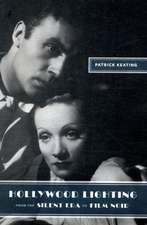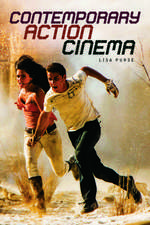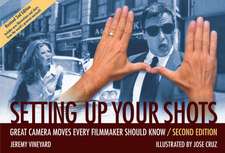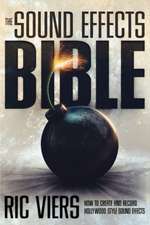Film and Television: A Guide to the Reference Literature: Reference Sources in the Humanities
Autor Mark Emmonsen Limba Engleză Paperback – 29 mar 2006 – vârsta până la 17 ani
Preț: 269.29 lei
Preț vechi: 324.04 lei
-17% Nou
Puncte Express: 404
Preț estimativ în valută:
51.56€ • 53.19$ • 42.74£
51.56€ • 53.19$ • 42.74£
Carte tipărită la comandă
Livrare economică 20 februarie-06 martie
Preluare comenzi: 021 569.72.76
Specificații
ISBN-13: 9781563089145
ISBN-10: 1563089149
Pagini: 384
Dimensiuni: 156 x 235 x 30 mm
Greutate: 0.62 kg
Editura: Bloomsbury Publishing
Colecția Libraries Unlimited
Seria Reference Sources in the Humanities
Locul publicării:New York, United States
ISBN-10: 1563089149
Pagini: 384
Dimensiuni: 156 x 235 x 30 mm
Greutate: 0.62 kg
Editura: Bloomsbury Publishing
Colecția Libraries Unlimited
Seria Reference Sources in the Humanities
Locul publicării:New York, United States
Notă biografică
Mark Emmons is Librarian and Associate Professor at the University of New Mexico. His lifelong passion for film led him to work briefly in the film and television industry immediately after graduating from UCLA in 1983. Realizing that he liked watching films more than making them, he explored a career in teaching before finding his niche as a librarian in 1990. As a librarian, he has selected books and films for the library collection, taught students how to conduct research, and answered reference questions about film and television. He has also written chapters on web-based film resources and on how to teach film research to undergraduates.
Cuprins
IntroductionIndexes and BibliographiesDictionaries and EncyclopediasGeneral Film and Television FilmographiesNational CinemaGenresFormatsStudiosPortrayalsFilmmakersScreenplaysMaking Films and Television ProgramsFilm and Television IndustryFans and AudienceAppendix A: Library of Congress Subject HeadingsAppendix B: Library of Congress Moving Image Genre/Form ListAppendix C: Library of Congress Classification-by SubjectAppendixD: Library of Congress Classification-by ClassificationAppendix E: Dewey Decimal Classification-by SubjectAppendix F: Dewey Decimal ClassificationIndex: Author and TitleIndex: Topical
Recenzii
Emmons's passion for the large and small screen is evident in this annotated bibliography of reference sources, for which he personally examined and described over 1,200 resources. Recognizing that movies and television are now legitimate areas of growing scholarly analysis, his work identifies print titles (exhaustively) and free and subscription Web sites (selectively). Beyond the standard bibliographies, encyclopedias, and even filmographies, works are organized by topic..Emmons reluctantly limits himself to English-language publications (but spends 46 pages on worldwide cinema) and excludes journalism, individuals and individual works, memorabilia, and trivia. Brief explanatory topic introductions precede carefully done, insightful source annotations that speak to quality, currency, and uniqueness. Appendixes provide bonuses: recommended LC subject headings; LC Moving Image Genre/Form List; a breakdown of LC classification PN1900 by subject, then by classification number, followed by similar information for Dewey. An excellent guide for researchers. Highly recommended. Lower-level undergraduates and above.
[O]ffers a useful introduction to the maze of literature already produced in this field for both the serious student and the researcher.
Film and Television: A Guide to the Reference Literature is an essential volume for any college or university library supporting programs in film and television studies. Intended as a starting point for research, it fills a decade-long gap in the reference literature by providing an updated and comprehensive bibliography for film and television studies' resources. Listings include print and electronic resource titles and Internet Web sites--a welcome addition..[t]his is a welcome and timely addition to the reference literature. Highly recommended.
Movies and television are fascinating subjects, but it is difficult to find information about them in one place. That need is met by this guide which is an annotated and comprehensive list of print and electronic sources..[t]he volume is valuable to film and television enthusiasts and an excellent collection development guide. It is recommended for academic and public library collections with film and television holdings.
Emmons provides 1,244 descriptions of titles divided into chapters on indexes and bibliographies, dictionaries and encyclopedias, filmographies, national cinema, genres, formats, studios, portrayals, filmmakers, screenplays, production, the industry, and fans. Given the vast number of published items in this area, Emmons's comments will help in making wise acquisitions choices.
[O]ffers a useful introduction to the maze of literature already produced in this field for both the serious student and the researcher.
Film and Television: A Guide to the Reference Literature is an essential volume for any college or university library supporting programs in film and television studies. Intended as a starting point for research, it fills a decade-long gap in the reference literature by providing an updated and comprehensive bibliography for film and television studies' resources. Listings include print and electronic resource titles and Internet Web sites--a welcome addition..[t]his is a welcome and timely addition to the reference literature. Highly recommended.
Movies and television are fascinating subjects, but it is difficult to find information about them in one place. That need is met by this guide which is an annotated and comprehensive list of print and electronic sources..[t]he volume is valuable to film and television enthusiasts and an excellent collection development guide. It is recommended for academic and public library collections with film and television holdings.
Emmons provides 1,244 descriptions of titles divided into chapters on indexes and bibliographies, dictionaries and encyclopedias, filmographies, national cinema, genres, formats, studios, portrayals, filmmakers, screenplays, production, the industry, and fans. Given the vast number of published items in this area, Emmons's comments will help in making wise acquisitions choices.
















